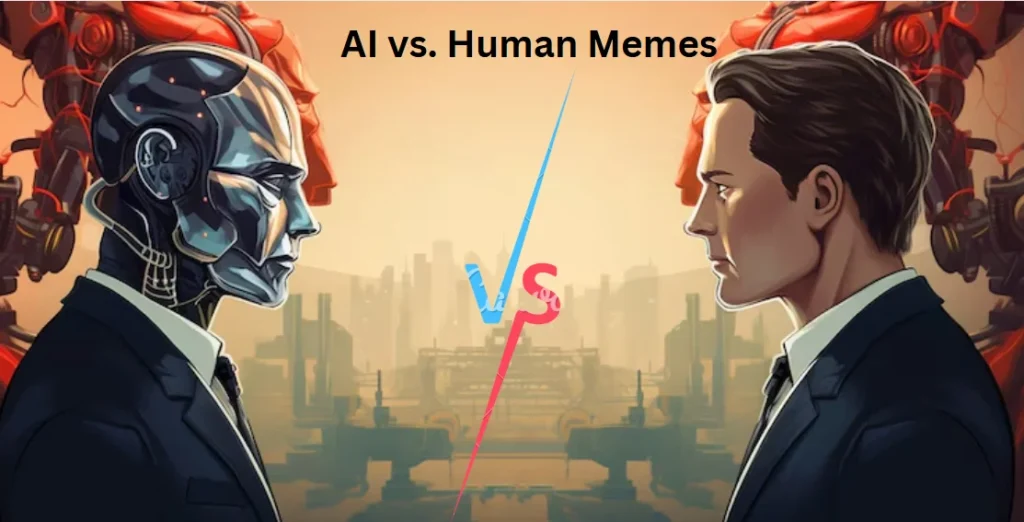Memes have become the internet’s native language—snappy, hilarious, and often brutally honest. But as artificial intelligence keeps evolving, we’ve reached a curious cultural crossroads: can machines make memes as funny as humans? To find out, we conducted a blind test, and the results may just change how you see your Instagram scroll forever.
Before we get into the juicy results, let’s set the stage for AI vs. Human Memes. AI meme generators are everywhere now, trained on countless meme formats and captions. You give them a topic, and they churn out a meme. Simple. But how does that stack up against classic human wit? We put both to the test in the wild.
The Test: AI vs. Human Memes Creation

We gathered a pool of 50 memes—25 created by humans, 25 generated by AI. Each meme was stripped of watermarks or any indicators of origin. Then, we sent these memes to over 1,000 participants aged 18 to 45, asking them to rate each meme on:
- Humor (scale of 1-5)
- Relatability (scale of 1-5)
- Likelihood to Share (scale of 1-5)
We didn’t disclose whether a meme was AI- or human-generated. This was a pure blind test, focused entirely on audience perception.
The Results: Surprisingly Close, But Humans Still Win
Let’s break down the average ratings from our test:
| Category | Human Memes | AI Memes |
| Humor | 4.2 | 3.8 |
| Relatability | 4.4 | 3.6 |
| Likelihood to Share | 4.1 | 3.7 |
The gap isn’t massive, but it’s consistent. Human-made memes scored higher in all categories, especially when it came to relatability, where the 0.8-point difference stood out.
Why Did Humans Win?
There are a few clear reasons:
- Cultural Nuance: AI still struggles with subtle social contexts, trends, and inside jokes that evolve fast on platforms like TikTok or Reddit.
- Timeliness: Human meme creators react in real-time to current events, which boosts shareability. AI tools rely on datasets that might not include last week’s viral moment.
- Tone: AI often misfires the tone, either being too neutral or too extreme. Humans are better at walking that delicate line between edgy and offensive.
But Here’s the Plot Twist…
In our blind test, 6 of the top 15 memes were AI-generated. The #2-ranked meme overall came from an AI. That suggests that when an AI does get it right, it can really hit the mark.
One of the top-performing AI memes combined a classic SpongeBob image with a painfully accurate caption about procrastinating on a 5-minute task for 3 days. Participants swore it had to be made by a human—proof that machine learning is catching up fast.
The Rise of AI-Powered Creativity
So what does this mean for meme culture? For creators and marketers alike, AI tools are becoming increasingly useful for idea generation, A/B testing, and scale. For instance:
- Marketers can use AI memes for quick, low-cost content during campaign testing phases.
- Creators can generate multiple formats from one idea to see what resonates best.
- Social media managers can use and learn AI to keep up with fast-moving trends when time is limited.
But the key here is hybrid creativity. AI is a fantastic tool, but it still needs a human touch to refine, contextualize, and inject real humor.
Actionable Tips: How to Use AI for Better Memes
Want to make the most out of this evolving tech? Here are some practical ways to merge AI efficiency with human wit:
1. Use AI for Brainstorming
Instead of starting from scratch, use a meme generator to produce a batch of ideas, then tweak the best ones with your personal spin. This cuts down on ideation time significantly.
2. Combine Formats
Try running the same caption through different AI templates (Drakeposting, Wojak, etc.) to see which format fits best. Then A/B test them on your audience.
3. Humanize the Captions
AI often outputs text that’s grammatically correct but lacks “voice.” Rewrite the captions with a bit of slang, sarcasm, or your brand’s tone to improve engagement.
4. Stay Updated with Trends
Feed your AI tool with recent content—upload trending meme examples or incorporate data from X (Twitter), TikTok, and Instagram. The more current the training data, the better the output.
What This Means for Meme Culture
We’re witnessing the dawn of a new kind of digital humor—co-created memes. Humans provide the wit, and AI handles the grunt work. And while humans still edge out AI in relatability and impact, the margin is narrowing.
In 2-3 years, we may not even know who made the memes we laugh at the most—and honestly, we might not care.
As long as it makes us laugh, does it matter?
Final Thoughts
Whether you’re a marketer, content creator, or just a meme-lover, the takeaway is clear: AI isn’t here to replace human humor, but to enhance it. The smartest strategy is to leverage both—let AI handle the heavy lifting, and use your human insight to craft the punchline.
Just remember, the best meme still starts with a good idea—and sometimes, the best ideas come from a machine that doesn’t even laugh.

